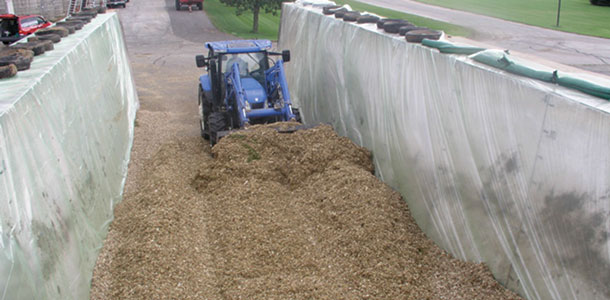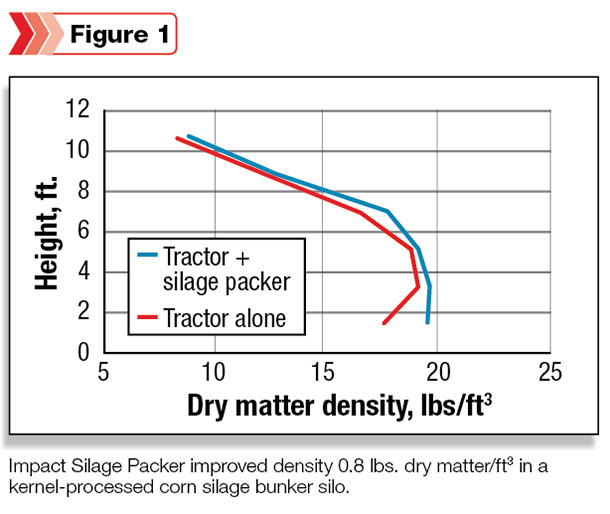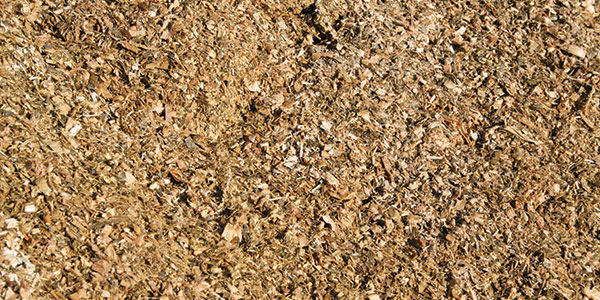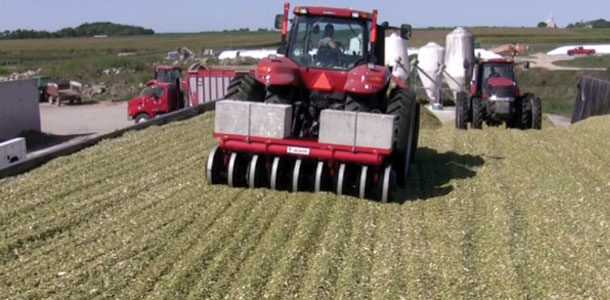So the key to low silage losses is to minimize the amount of oxygen that gets into silage. How do you do that? There are three critical steps: Pack to a high density, seal the crop in storage with a good-quality plastic film that is held tightly to the crop surface, and feed out at a high rate from the face. That shouldn’t be news.
However, today there are some new options to achieving a high density and sealing bunkers or piles. This article discusses recent research we have done to evaluate the value of some of these options.
Packing to a high density
Achieving a high density in a bunker or pile has typically focused on spreading each load thinly, packing with heavy tractors and spending as much time per ton packing as possible.
As harvest rates have increased, it has become more difficult to keep packing time per ton high. Adding more weight to the packing tractor or spreading each load over a wider area can counteract a loss of packing time.
With big bunkers or piles, it is possible to increase packing time by adding packing tractors of similar weight. With small bunkers, it may not be feasible or safe to add more packing tractors. However, filling more than one storage simultaneously is a way to add more packing tractors safely.
In recent years, a number of devices that attach to a packing tractor have come on the market to improve silage density. One of those devices is the “Impact Silage Packer.” It weighs 10,000 pounds and attaches to the three-point hitch. We were curious to see how much it would affect silage density.
We filled two 50-foot x 200-foot x 12-foot bunker silos with corn silage. We had three similar 30,000- pound tractors for filling: one for spreading and one for each side for packing.
The Impact Silage Packer was added to one of the packing tractors. Incoming loads of chopped corn were dumped and spread on alternating sides of a bunker. Packing time per ton was kept similar for both sides.
During filling of the first bunker, we noticed the initial three-point hitch setup was not free-floating, thus limiting the silage packer weight on the silage and transferring some of the weight to the tractor.

So the results from that bunker were not considered a fair comparison. In the second bunker, the Impact Silage Packer did produce modest benefits (Figure 1), averaging 0.8 pounds dry matter per cubic foot in kernel-processed corn silage.
At another research farm, two bunkers were being filled simultaneously with alternating loads of kernel-processed corn silage, and an Impact Silage Packer was being used.
During the filling of the top third of one silo, we had the crew pack with the silage packer raised on the three-point hitch so that the weight was transferred to the rear axle of the tractor.
The other bunker was packed with the packer running on the forage. While this was not a controlled trial, the density in the top third of the silo packed with the silage packer operated normally produced a higher density than that when the packer was used in a raised position.
So overall, the Impact Silage Packer worked best when the three-point hitch allowed the packer to fully exert its weight while riding on the forage. In our trial, it provided modest improvements in density.
Sealing the silo well
Spoiled silage at the top of a bunker or pile is a common sight. Unfortunately, it presents producers with a real dilemma. Do you feed the spoilage and risk the health of your herd from potentially feeding mycotoxins, listeria or other pathogens?
Or do you risk the safety of the farm hand who removes the spoiled silage?
The best alternative is to do such a good job of sealing the silo so there is no spoiled silage, and today we have the technology to do that. There are two critical components to eliminating top spoilage: the quality of the plastic film and how well it is held against the crop.
Over the years, we have studied various plastic films on bunker silos, splitting the top surface to compare different types. The most common plastic film is polyethylene, white or black, of varying thicknesses, typically 5 to 8 mm.
What we found comparing different types of polyethylene is that color has little effect on losses, but thickness does. For example, there was a five-point improvement in dry matter recovery in the top 6 inches under 8.5-mm polyethylene compared to that under a 6-mm polyethylene.
Today, there are a number of oxygen-barrier films on the market. One system uses a reduced oxygen permeability plastic covered by a second layer of polyethylene or a tarp.
Other systems place a layer of reduced oxygen permeability plastic polymer between layers of polyethylene during the manufacturing process.
These systems greatly reduce how much oxygen can pass through the plastic and enter the silage. In our trials, we have experienced very low dry matter losses in the top 6 inches under these films.
In the three types we have tested, losses in the top 6 inches are normally less than 5 percent with no visual evidence of spoilage. That said, we have seen results almost as good with an 8.5-mm polyethylene, but 8.5-mm is not common.
Quality of film is not the full answer to preventing spoiled silage at the top. Sheets need to be overlapped sufficiently (at least 4 feet), and the overlaps secured with gravel bags or tires butted together.
More than that, if any film is billowing in the wind, it can act like a bellows drawing in air around the edges of the sheet and permitting spoilage. To prevent this, the standard tires-touching-tires keeps the plastic in place.
Today a number of tarps (woven or expanded mesh) secured with gravel bags are available that can do a similar job of keeping the plastic tight to the silage. These tarps need to be reused for multiple years to be cost-effective. In snowy places like Wisconsin, it is best to have narrow tarps laid parallel to the feedout face for easier removal during winter.
A particular problem with bunker silos is shoulder spoilage at the walls. This is caused by air infiltrating between the wall and the cover plastic as well as rain running off the plastic and through the silage at the wall.
An effective way of eliminating shoulder spoilage is to place plastic down the walls prior to filling. These side-wall sheets should lap onto the forage top at least 4 feet at the end of filling, be covered by the cover sheet and then secured by gravel bags or tires butted together.
Side-wall film not only eliminates shoulder spoilage, it also limits oxygen penetration through concrete and cracks in the concrete and keeps silage acids from etching the concrete walls, extending their life.
The final issue of sealing is at the bunker ends or the edges of the pile. It is important to have a tight seal with the ground or pad. Extend at least 4 feet of plastic onto the ground or pad and provide a continuous weighting on that film. Weighting can be soil, sand, gravel or gravel bags butted together. These typically will produce better results than tires.
The bottom line in all these sealing recommendations is to buy a quality plastic film to minimize oxygen passing through the film and secure it well to minimize oxygen entering under the edges of the sheets.
Make sure to frequently inspect the plastic and repair holes that develop during storage. Do those things and questions about pitching or feeding spoiled silage will disappear. FG
Brian J. Holmes is a professor emeritus with University of Wisconsin – Madison.
PHOTOS
PHOTO 1: Corn silage bunker being packed with a tractor with Impact Silage Packer
PHOTO 2: Placing plastic on bunker walls at the start of filling to help eliminate shoulder spoilage.
PHOTO 3: Silage Photos courtesy of Richard Muck. 
Richard Muck
Research Agricultural Engineer
USDA-ARS – U.S. Dairy Forage Research Center









